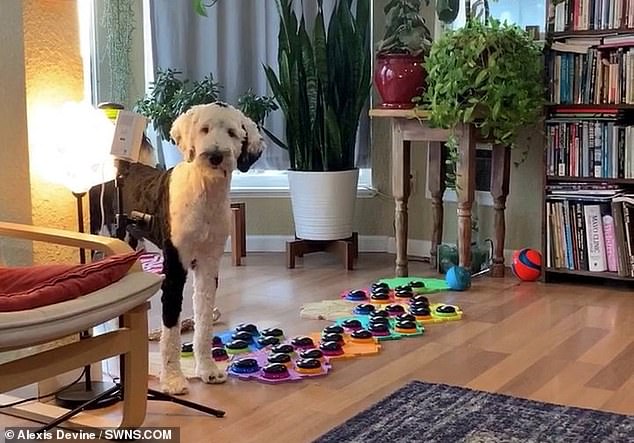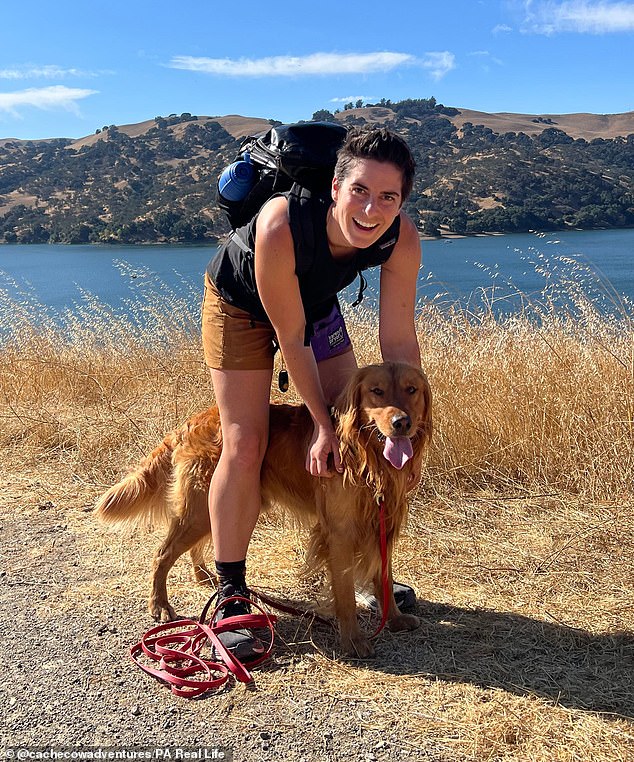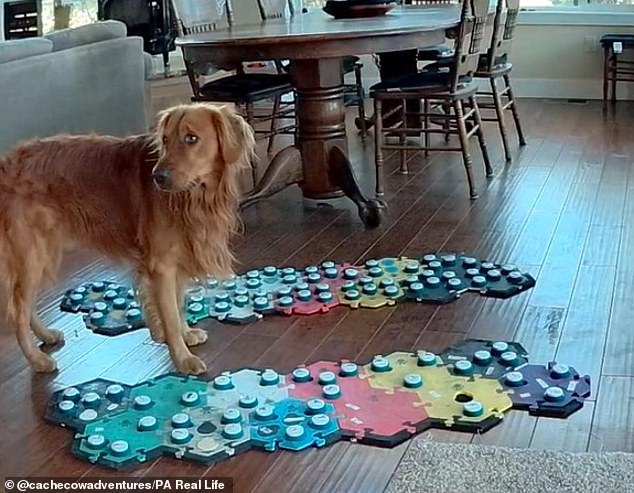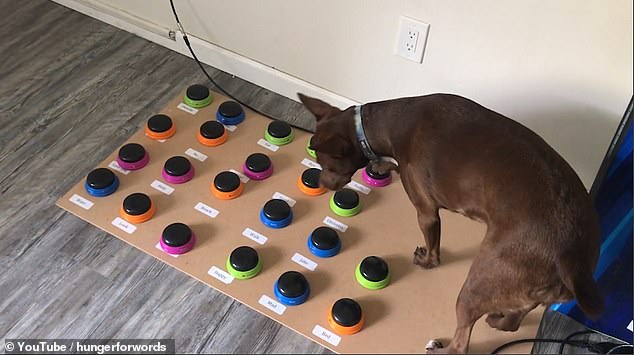Dogs can TALK to you by pressing buttons, scientists confirm – here’s how to try it with your pet
If you’ve ever felt like your dog was trying to tell you something, scientists now say you don’t have to be Dr. Doolittle to know what’s going through his mind.
Researchers at the University of California, San Diego, have discovered that dogs can actually ‘talk’ to their owners using soundboard buttons.
During COVID lockdowns, avid dog owners have managed to teach their pets to communicate using a series of buttons that play sounds when pressed.
The astonishing communication skills of some dogs have raised public skepticism, but researchers now say these impressive four-legged friends do know what they’re saying.
So if you’re in the mood to chat with your furry friend, here’s how to try it yourself.
Researchers at UC San Diego have discovered that dogs actually know what they are saying when they communicate via soundboards. Pictured: Dog and their soundboard from the UC San Diego Comparative Cognition Lab study
What is soundboard training?
It can often be difficult to determine what your dog wants based on the barking and whining.
But soundboard or button training is a way to give your dog more tools to communicate his needs and wants.
Trainers give their dogs a “soundboard” consisting of separate buttons, each programmed to produce a different word.
These can range from simple objects and places like ‘park’, ‘cat’ or ‘food’ to more abstract ideas like ‘want’, ‘happy’ or ‘sad’.
When the dog wants to communicate with its owner, it can press these buttons with its paw to string together series of words.
One dog, a sheepdog named Bunny, became internet famous when his owner filmed his soundboard training progress.
In the beginning, Bunny couldn’t do much more than press a specific button when she wanted to go outside or pee.
But soon Bunny’s vocabulary expanded to the point where she could ask to play, go outside, and even tell her owner, Alexis Devine of Tacoma, Washington, that she loved her.

Bunny the sheepadoodle shot to internet fame when her owner posted a video of the 11-month-old dog communicating with a soundboard. However, the public is skeptical about whether dogs like Bunny really understand the meaning of the words they use
What did the research yield?
When these videos went viral, many claimed that dogs like Bunny could not possibly “talk” in the conventional way.
These skeptics, on the other hand, argue that the dogs simply press the buttons in response to their owner’s actions, without really understanding what the actions mean.
According to Dr. Federico Rossano, a cognitive scientist at UC San Diego and lead author of the study, this research was specifically aimed at debunking those claims.
Researchers first visited the homes of 30 dog owners in the US to test their response to sounding board signals.
During the COVID-19 peak of 2022, 29 dog owners continued the trials at home, under remote supervision.
Contrary to public skepticism, these studies have provided evidence that dogs trained to use soundboards actually understand the meaning of words.
The researchers found that dogs responded correctly to words like “play” and “outside,” regardless of whether they were spoken by their owners or by pressing a button.
Furthermore, the dogs responded in the same way when the buttons were pressed by another person.
Dr Rossano says: ‘Our findings are important because they show that words matter to dogs, and that they respond to the words themselves, not just the accompanying signals.’
Previous research has shown that dogs have a surprisingly good command of human language.

Christina Lee (pictured) taught her dog Cache more than 130 words using buttons. The researchers in this study say that Cache probably understands what each of those buttons means
In a 2022 study, researchers played clips of dogs that contained either real language or nonsense from Spanish or Hungarian.
Using an fMRI machine, the researchers found that the two clips activated different parts of the dogs’ brains, suggesting that the dogs could hear the difference between two languages.
Other research shows that dogs can learn up to 215 different words from their owner’s language.
Dr. Rossano says, “We’re just scratching the surface in this study. Future studies will examine how dogs actively use these buttons, including the meaning and systematics behind sequences of button presses.”

Cache can press buttons on the mat to request cuddles, see specific people, or just ask for attention. In the study, dogs responded to the button sounds regardless of who was pressing them, suggesting they weren’t just picking up on cues from their owners
How can you teach your dog to communicate using buttons?
Even though your dog may not yet speak English fluently, the first steps of training the buttons are quite simple.
The first thing you need to do is gather the materials to make the soundboard.
There are options available specifically designed for this purpose, but some dog owners have also had success with foam floor tiles and simple, recordable buzzers.
Then the American Kennel Club recommends starting with simple words that your dog already associates with and likes.
For example, you can select “outside” or any other word you say when walking the dog and record that on the first button.
Christina Hunger, dog trainer and author of How Stella Learned to Talk, explains in a message on her website that you must ‘keep your words’.
Mrs. Hunger writes, “We need to be aware of our own vocabulary patterns because our dogs learn what we say.
‘For example, when I talk about meals, I instinctively say “eat” most often. But you might say “food” or “hunger” more often than “eat.”‘
But before you start training your dog to press the button, you must first make the connection between the button and the word.
Once you have one or two buttons prepared, make sure you press the button every time you perform the associated activity.
In this case, you would press the ‘outside’ button every time you take the dog out.

Dog owner Christina Hunger, 26, taught her pet Stella to use a specially adapted keyboard. Her advice is to observe what words you use to talk to your dog and train him with those words first
Over time, your dog will make the association between the button and the desired activity and will press the button himself.
To strengthen the bond, reward your dog with affection or a treat and then immediately give him what he wants.
This teaches your dog that he can use the button to tell you what he wants, laying the foundation for future training.
Once that’s established, you can gradually add more words and more buttons.
If you keep this process going, your dog will soon be able to chatter freely on his new sounding board.
